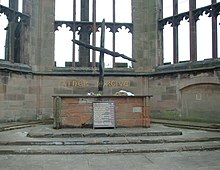Coventry Cathedral
The Coventry Cathedral (also known as St Michael's Cathedral known) in Coventry ( England ) is the seat of the Anglican Bishop of Coventry and the Diocese .
The city had three cathedrals over the years. The first was St Mary’s , a monastery building of which only a few ruins remain. The second was St Michael’s , which was destroyed in a German air raid on Coventry in November 1940 , only the large tower and some outer walls remained. The third cathedral is today's St Michael's Cathedral , which was built right next to the ruins after the previous building was destroyed.
St Mary's
St Mary's Priory and Cathedral was founded as a Benedictine monastery in 1043 by Leofric , the Earl of Mercia , and his wife Lady Godiva . However, the first renovation work began shortly afterwards. Between 1095 and 1102, Bishop Robert de Limesey moved the episcopal see from Lichfield to Coventry and by the 13th century the small monastery became a cathedral about 130 m in length and numerous larger outbuildings. In 1539 the cathedral lost its status when Henry VIII dissolved the Catholic monasteries.
St Michael's
The St Michael's Church was built in the late 14th or early 15th century. It was the largest parish church in England when it was elevated to cathedral status in 1918 when the Diocese of Coventry was founded.
On November 14, 1940, the cathedral was almost completely destroyed in a bombing raid by the German air force . Only the church tower and the outer walls remained. These ruins are still a place used for worship services today.
In 1961 , volunteers from the Action Reconciliation Service for Peace built an international meeting place for reconciliation in the substructure of the ruin .
Wooden cross, cross of nails and Stalingrad Madonna
During the clean-up work after the air raid, Richard Howard, then provost of Coventry, had a simple wooden cross made from two of the burned roof beams of the ruin. This wooden cross can be seen in the new cathedral; a duplicate is placed in the chancel of the ruins of the old cathedral.
Another, smaller cross was put together from three carpenter nails from the old cathedral and is now in the new building of the cathedral. The Cross of Nails from Coventry became a symbol of the ecumenical Cross of Nails Movement that began in Coventry and which today has over 160 prayer communities around the world. As a sign of solidarity with the idea of reconciliation, each place in the global community receives a cross of nails, which, like the original cross, consists of three nails.
One of the nails was donated in 1988 as a sign of reconciliation to the Kaiser Wilhelm Memorial Church in Berlin , which was also destroyed by air raids and is regarded as the “sister church” of Coventry Cathedral due to its architectural design (preservation as a ruin and a new building next door). Other symbolic places of the cross of nails in Germany are St. Nikolai (Kiel, since 1947), St. Marien (Lübeck, since 1971) and the rebuilt Frauenkirche (Dresden, since 2005). A copy of the Stalingrad Madonna - a drawing that Kurt Reuber made at Christmas 1942 at the Battle of Stalingrad - now hangs in a chapel in the cathedral. With a symbolism similar to that of the cross, the original is also in the Kaiser Wilhelm Memorial Church and another copy in the Russian Orthodox Cathedral in Volgograd to indicate a reconciliation between three once warring countries.
St Michael's Cathedral


The new St Michael's Cathedral was built next to the remains of the old one and designed by Basil Spence and Arup .
Spence insisted on leaving the old cathedral as a garden of remembrance and adding the new one so that the two buildings together form a church. When looking for an architect, his design was selected from over 100 submitted works.
The foundation stone for the new cathedral was laid by Queen Elizabeth on March 23, 1956 , and in 1960 she knighted Basil Spence as a Knight Bachelor in recognition of his achievements for Coventry .
The inauguration of the new cathedral took place on May 25, 1962. On this occasion, Benjamin Britten's War Requiem was premiered on May 30 . As with its German counterpart, the Kaiser Wilhelm Memorial Church, the modern design caused much controversy.
The unconventional spire ( Flèche ) was placed on the flat roof of the cathedral by a helicopter. The interior is known for a large tapestry with the image of Christ by Graham Sutherland and an abstract window in the baptistery designed by John Piper .
organ
The organ was built in 1962 by the organ builder Harrison & Harrison. The instrument, with its modern design in its brochure , is divided into two locations - north and south of the choir, with the front facing the nave. The Swell and Solo organs are on the north side and the Great Organ on the south side. The pipes of the choir and pedal organ are on either side of the altar. The instrument has a total of 72 stops on four manual works and a pedal . The actions are electro-pneumatic.
|
|
|
|
|
||||||||||||||||||||||||||||||||||||||||||||||||||||||||||||||||||||||||||||||||||||||||||||||||||||||||||||||||||||||||||||||||||||||||||||||||||||||||||||||||||||||||||||||||||||||||||||||||||||||||||||||||||||||||||||||
Individual evidence
- ↑ Information about the organ and the disposition
Web links
- Official website (English)
- Historic Coventry (English)
- Virtual tour of the new cathedral (English)
Coordinates: 52 ° 24 ′ 30 " N , 1 ° 30 ′ 25" W.




